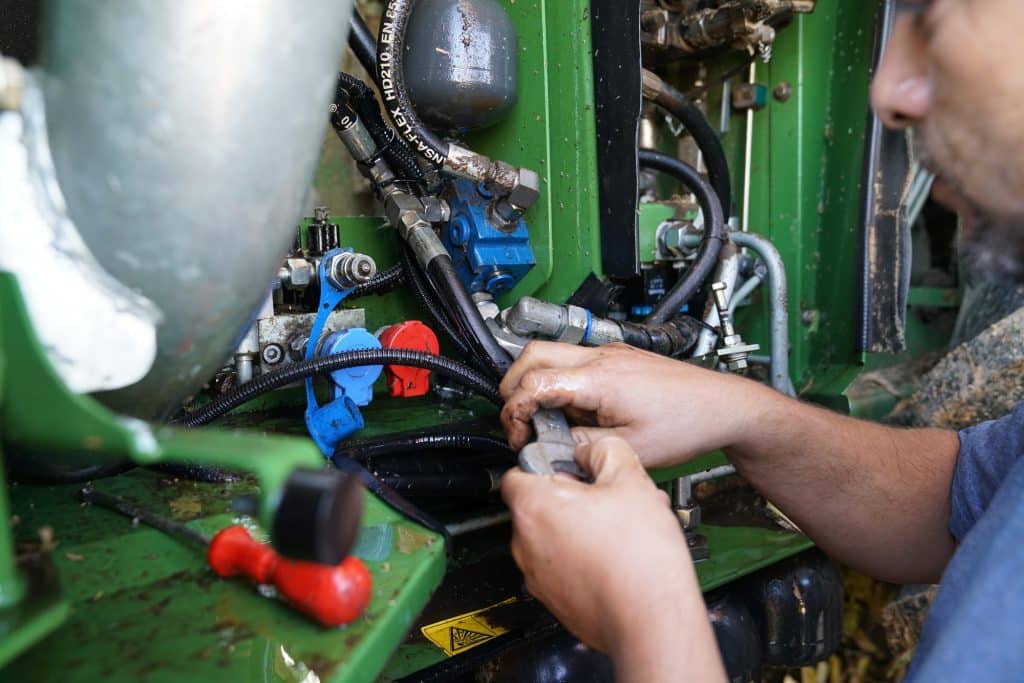Hydraulic systems are the lifeblood of numerous types of industrial equipment. When these systems fail, they can bring an entire operation to a standstill; this leads to costly downtime. With a solid maintenance plan, you can help ensure your hydraulic equipment stays running at peak efficiency.
Let’s delve into eight essential tips for hydraulic equipment maintenance.
- Regularly Check Fluid Levels
Consistent operation of hydraulic systems relies on maintaining optimal fluid levels. This crucial aspect ensures that the system’s mechanical components are adequately lubricated, allowing smooth operations. Proper fluid level monitoring reduces the risk of equipment failure and helps achieve a prolonged equipment lifespan.
To ensure your hydraulic fluid levels are correctly maintained, consider the following tips:
- Always allow the equipment to cool down before checking fluid levels to prevent inaccurate readings.
- Use a dipstick or sight glass for accurate measurements.
- Always top up with the same type of hydraulic fluid to avoid system complications.
- Refer to the equipment manual for recommended fluid levels and do not overfill or underfill.
Incorporating these steps into your routine maintenance ensures your hydraulic equipment operates reliably and efficiently.
- Maintain Cleanliness Of Hydraulic Fluid
Keeping hydraulic fluid clean helps to prevent wear and tear, thereby extending the life of your equipment. So, inspect the fluid for any signs of contamination, such as metal particles or water. Use filters to keep the fluid clean and replace them as per the manufacturer’s guidelines. These will ensure the hydraulic fluid remains clean, reducing the risk of system failure and extending the equipment’s lifespan.
- Inspect Seals Regularly
Examining hydraulic seals regularly is another essential task. Faulty seals can lead to fluid leaks, causing inefficiency and potential system damage. Here are some effective methods to accomplish this:
- Regularly inspect for any visible signs of leakage around the seals.
- Use a seal conditioner to prevent drying or cracking.
- Follow the manufacturer’s guidelines for replacing seals at recommended intervals.
Regular inspections and preventive maintenance can significantly reduce the risk of seal failure, ensuring optimal performance and system durability.
- Monitor Operating Temperatures
Monitoring operating temperature is a critical step in hydraulic equipment maintenance. High temperatures can cause damage, reducing system efficiency and leading to potential failures.

Here are some tips to monitor your system’s operating temperature correctly:
- Utilize reliable temperature monitoring devices that offer real-time data, facilitating timely interventions when temperatures approach dangerous levels.
- Regularly check and maintain the cooling systems, ensuring they are clean and functioning properly to manage heat effectively.
- In hydraulic systems, monitor the fluid temperature closely, as an increase could indicate issues such as internal leakage or inefficiencies in the cooling system.
With these tips, maintaining the operating temperature within safe limits becomes more manageable. This proactive approach helps enhance hydraulic equipment’s performance, reliability, and lifespan.
- Inspect External Parts
Inspection of external parts is a crucial aspect of hydraulic equipment maintenance. Regular checks help identify signs of wear and tear, thus preventing potential internal damage.
- Start with a visual inspection for any evident signs of damage, such as leaks, corrosion, or cracks.
- Manually check the firmness of connections, ensuring hoses, fittings, and other components are secure.
- Pay special attention to seals, as they are essential to maintaining the integrity of the hydraulic system.
Implementing these steps can help catch minor issues before they escalate into major problems. Regular inspection of external parts can significantly enhance the durability and reliability of hydraulic equipment.
- Keep The Equipment Calibrated
Consistent calibration of hydraulic equipment is vital to maintain its operational integrity and prolong its lifespan. This procedure ensures accurate readings and operations, reduces instances of equipment breakdowns, and promotes workplace safety.
- Use A Calibrated Gauge: It’s necessary to check pressure readings with a calibrated gauge periodically. This step identifies irregularities that might not be detected during regular operations.
- Follow The Manufacturer’s Guidelines: These guidelines provide accurate calibration instructions. Adhering to them is crucial to ensure optimum equipment performance.
- Engage Professional Services: For complex equipment, hiring professional services for calibration can be a wise decision. These experts can ensure precision and potentially spot future issues.
Proper calibration serves as the cornerstone of hydraulic equipment maintenance. These steps will ensure efficient and safe operations, reducing long-term costs and potential hazards.
- Replace Worn-Out Parts
Timely replacement of worn-out parts is critical in hydraulic equipment maintenance. This prevents further damage to the machinery and safeguards operational efficiency and safety.
- Regular Inspection: Conduct systematic examinations to identify wear and tear, as any sign of abnormality calls for immediate attention.
- Use Quality Replacements: Replace any worn parts with high-quality components. Inferior parts could compromise equipment longevity and safety.
- Adhere To Replacement Schedules: Follow the manufacturer’s guidelines regarding the lifespan of components and their replacement.
Proactive replacement of worn-out parts in hydraulic equipment can mitigate potential operational interruptions. This approach enhances overall equipment efficiency and longevity, ensuring safer and more reliable operations.
- Service Equipment Regularly
Regular servicing plays a crucial role in hydraulic equipment maintenance. It ensures optimal functioning, prevents unexpected breakdowns, and promotes a safer working environment.
- Service Schedule: Adhere to the manufacturer’s suggested servicing schedule. Regularly scheduled maintenance helps in preempting potential issues.
- Document Servicing: Keep detailed records of all servicing tasks performed. This provides a reference for future maintenance and helps identify recurring problems.
- Qualified Technicians: Always entrust servicing to skilled and trained technicians. They ensure all maintenance tasks are performed correctly and efficiently.
Regular servicing is essential for hydraulic equipment. Proper execution and documentation of these tasks safeguard operational efficiency, longevity, and workplace safety, fostering a productive and secure work environment.
Conclusion
In the world of industry, hydraulic equipment is crucial. Regularly inspecting fluid levels, maintaining cleanliness, checking seals, monitoring temperatures, looking at external parts, calibrating equipment, replacing worn-out parts, and servicing regularly can all contribute to smoother operation and longer life for your hydraulic equipment. The adage’ Prevention is better than cure’ holds particularly true when maintaining hydraulic equipment.






